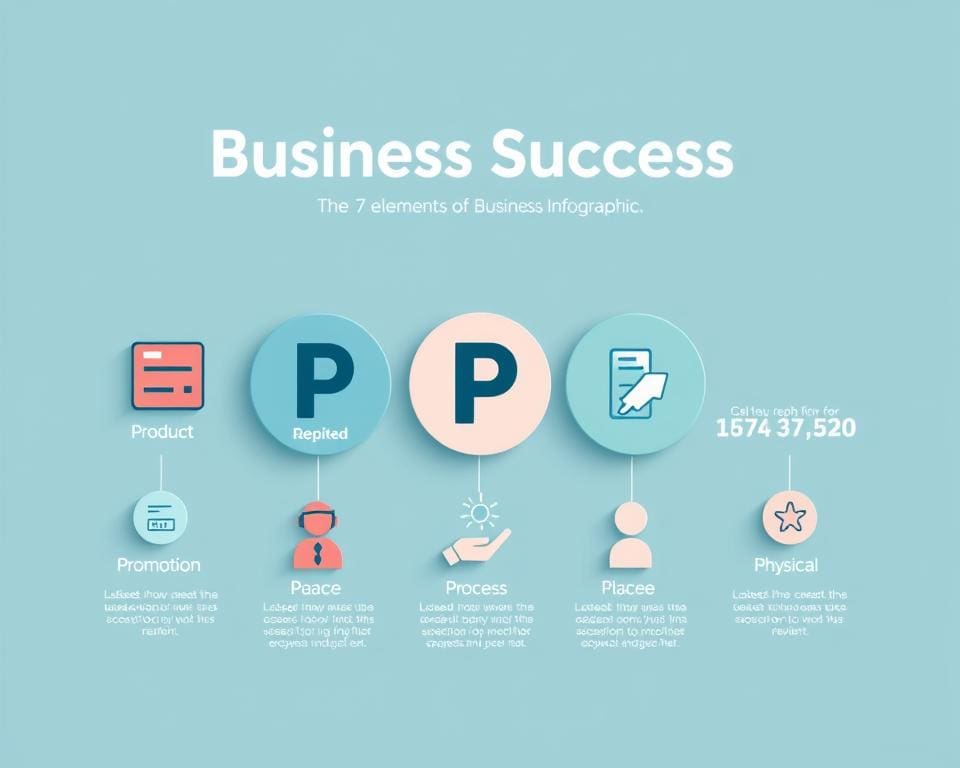The concept of the 7Ps in business serves as a transformative framework within the marketing mix, vital for companies aiming to excel in their strategies. Each of the 7Ps—Product, Price, Place, Promotion, People, Process, and Physical Evidence—offers businesses a comprehensive toolkit to optimise their marketing efforts. By exploring what the 7Ps in business entail, organisations can effectively enhance their market impact and navigate the complexities of consumer behaviour. Originating from the insights of E. Jerome McCarthy in the 1980s, this framework has become an essential part of modern business strategy. Embracing these elements can lead to innovative solutions and a pathway toward market success.
The Importance of the Marketing Mix
In the competitive landscape of modern business, understanding the marketing mix proves invaluable. This framework serves as the backbone for crafting effective marketing strategies, allowing organisations to align their efforts with both customer needs and market demands. The significance of this approach cannot be overstated, as it directly impacts business success.
Defining the Marketing Mix
The marketing mix comprises a blend of strategic components that work together to provide a coherent customer experience. Recognising the importance of marketing within such a framework involves identifying the right combination of the 7Ps: Product, Price, Place, Promotion, People, Process, and Physical Evidence. Each element contributes uniquely to meeting customer expectations and driving business effectiveness.
The Role of the 7Ps in Modern Business
In today’s rapidly evolving market, the 7Ps provide essential insights into changing consumer behaviours and preferences. Adapting these elements encourages organisations to remain competitive and relevant. Through strategic marketing, businesses can tailor their offerings, ensuring they not only address current challenges but also prepare for future opportunities.

Understanding Product in the 7Ps
The ‘Product’ element of the 7Ps marketing mix plays a vital role in determining overall business success. Understanding the significance of various types of products and the different stages of the product lifecycle can empower marketers to craft effective strategies.
Types of Products and Their Significance
Products can generally be classified into several categories that serve distinct purposes in the marketplace. The types of products include:
- Tangible goods, which are physical items that consumers can buy, use, and perceive. Examples range from electronics to clothing.
- Intangible products, predominantly services that offer benefits but do not take a physical form, such as consultancy or education.
- Consumer products that cater directly to the personal needs of customers, including convenience goods and luxury items.
- Industrial products, utilized by businesses for further production or operational purposes, such as machinery and raw materials.
The product significance lies in its ability to fulfil customer needs and differentiate a brand from competitors, making it essential for businesses to clearly identify their offerings.
Product Lifecycle and Marketing Strategies
The product lifecycle consists of several stages: introduction, growth, maturity, and decline. Each stage demands tailored marketing strategies to maintain relevance and boost profitability. During the introduction stage, awareness is generated through advertising, while growth necessitates competitive pricing to capture market share. The maturity phase often requires innovation or rebranding to reinvigorate interest, and decline may lead to strategic decisions such as discontinuation or repackaging.
For example, companies like Apple continually refresh their product lines, showcasing the importance of adapting marketing strategies to extend the product lifecycle effectively.
What Are The 7Ps In Business
The overview of 7Ps provides invaluable insights into the essential components that form the foundation of effective marketing strategies. This structured approach, known as the 7Ps framework, encompasses Product, Price, Place, Promotion, People, Process, and Physical Evidence. Each element plays a distinct role while simultaneously contributing to the holistic success of marketing efforts.
An Overview of the 7Ps Framework
Understanding the 7Ps framework helps businesses in crafting their marketing plans with precision. Each ‘P’ works in concert, creating a dynamic marketing mix that addresses the needs and preferences of target audiences. A well-defined product can set the stage for strategic pricing, enhance promotional campaigns, and influence distribution choices. This interdependence ensures a rhythmic alignment among the various marketing mix elements.
How the 7Ps Interact with Each Other
Exploring the interaction of marketing mix elements reveals how modifications within one area can ripple through other components. For instance, an upgrade in Product features may lead to a price increase, necessitating adjustments in promotional tactics. Similarly, changes in promotional strategies might influence how consumers perceive the value of the Product, further affecting pricing. Recognising these interactions fosters a coherent approach to marketing, ensuring that all elements function collaboratively rather than in isolation.
Navigating Price Strategies
Price serves as a crucial element in a business’s marketing mix, influencing both consumer behaviour and overall profitability. Multiple price influence factors play a vital role in shaping effective pricing strategies, which can determine a business’s competitive edge in the market.
Factors Influencing Pricing Decisions
Understanding the various price influence factors is essential for crafting a solid pricing strategy. Key factors include:
- Cost of production: Ensuring that prices cover manufacturing and operational costs while allowing for profit margins.
- Competition: Evaluating competitor prices helps businesses position their own offerings effectively.
- Customer perceptions: Pricing communicates value; businesses must consider how customers perceive their products or services.
By analysing these factors, businesses can implement pricing strategies such as penetration pricing, which aims to attract customers with lower prices initially, or skimming pricing, where higher prices are set to maximise profits from early adopters.
Psychological Pricing Techniques
Psychological pricing plays a significant role in influencing consumer purchasing decisions. Effective techniques can include:
- Pricing products at £9.99 instead of £10 to create an impression of a better deal.
- Offering bundles or discounts that highlight savings, encouraging customers to buy more.
- Utilising tiered pricing to appeal to different customer segments, thereby maximising business profitability.
Employing such psychological pricing techniques not only enhances perceived value but also drives sales and encourages brand loyalty.
The Influence of Place in Distribution
In today’s competitive landscape, the role of ‘Place’ in the marketing mix cannot be understated. Effective distribution strategies play a crucial part in ensuring that products reach their intended audience, making the selection of appropriate distribution channels vital. Businesses must contemplate how both online marketing and offline presence can shape their distribution efforts.
Choosing the Right Distribution Channels
Selecting the right distribution channels involves analysing where and how customers prefer to purchase products. A multi-channel approach often proves to be the most effective. Businesses need to consider the following aspects:
- Understanding customer buying habits and preferences
- Evaluating the cost-effectiveness of various distribution methods
- Assessing the geographical areas served by different channels
Retail giants like Amazon excel in online marketing, leveraging their vast distribution network to ensure swift delivery. In contrast, companies like Tesco emphasise an extensive offline presence, allowing them to cater to consumers who prefer traditional shopping experiences. Balancing these approaches ensures that businesses can tap into diverse consumer bases effectively.
Online vs. Offline Presence in Modern Marketing
The interplay between online and offline presence is significant in contemporary marketing strategies. While online marketing offers the flexibility of reaching a global audience at lower costs, offline presence builds trust and provides a personal touch that many consumers still value. Businesses must decide how to allocate resources between these channels to optimise their overall reach and effectiveness.
The Power of Promotion in the 7Ps
Promotion serves as a vital component of the marketing mix, shaping how brands communicate with their audiences. Employing various promotion strategies can significantly strengthen a brand’s presence and drive consumer engagement. Each approach, from advertising techniques to public relations, plays a role in achieving marketing objectives. The budget, target market, and specific goals dictate which strategies will prove most effective.
Different Promotion Strategies Explained
Promotional strategies encompass a variety of methods designed to raise awareness and stimulate interest. Key strategies include:
- Advertising — Utilising media channels such as television, radio, and online platforms to reach the target audience.
- Public Relations — Crafting a positive image through press releases, events, and community engagement.
- Sales Promotions — Offering temporary incentives such as discounts, coupons, or free trials to encourage quick purchases.
These elements within the promotional mix enable brands to effectively connect with consumers and enhance their market position.
Leveraging Digital Marketing Techniques
The rise of digital marketing has transformed how brands engage with their customers. Companies like Nike effectively utilise social media campaigns and influencer partnerships to build brand loyalty. Key digital marketing techniques include:
- Content Marketing — Creating valuable content that attracts and retains customers.
- Search Engine Optimisation (SEO) — Enhancing online visibility through strategic keyword usage and relevant content.
- Email Campaigns — Sending targeted communications to nurture customer relationships.
By integrating these techniques into their promotional strategies, businesses can better connect with their audience, ensuring that their message resonates effectively in the digital landscape.
The Role of People and Process in Business Success
In the ever-evolving landscape of business, the significance of ‘People’ and ‘Process’ cannot be overstated, particularly within the framework of the 7Ps. Staff interactions play a vital role in shaping the customer experience, influencing perceptions and fostering loyalty. Well-trained employees, equipped with the right skills and motivation, are fundamental in delivering exceptional service. Examples of organisations like Zappos illustrate how a commitment to empowering staff can cultivate an environment of enthusiasm and dedication to customer satisfaction.
Equally important are the business processes that underpin organisational success. Streamlined operations enhance efficiency, allowing businesses to respond swiftly to customer needs and market changes. By analysing processes, companies can identify bottlenecks and make informed improvements that enrich the overall customer experience. This synthesis of skilled personnel and refined procedures is the backbone of a robust business model, enabling firms to operate competitively.
In summary, investing in both people in marketing and efficient business processes equips organisations to thrive in competitive environments. The combination of motivated staff and effective operations not only improves customer experiences but also builds a reputation that can set a brand apart in the marketplace. Truly, in the quest for success, the human element and operational finesse work hand in hand to create lasting impressions and drive organisational achievements.









